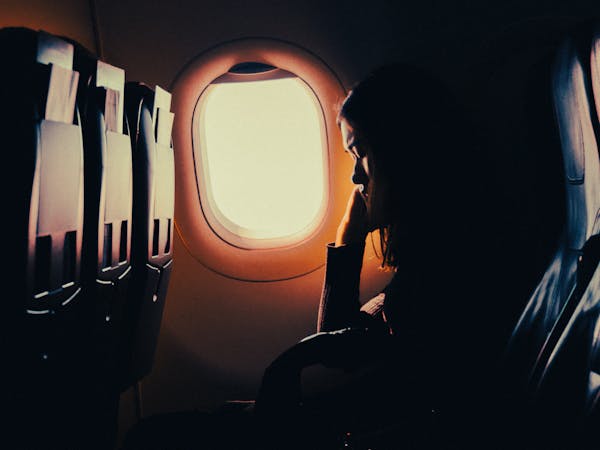Are you tired of arriving at your destination feeling more jet-lagged than refreshed? The incessant hum of engines, cramped seating, and dry cabin air can make sleeping on a plane an elusive dream. But fear not, weary traveler! This comprehensive guide, packed with expert advice from doctors and seasoned globetrotters, will transform your flight into a rejuvenating oasis. Prepare to unlock the secrets to a restful journey and wake up feeling revitalized.
Understanding the Science of Sleep in the Sky
To optimize your sleep on a plane, it's crucial to grasp the physiological challenges posed by air travel. The lower cabin pressure, reduced humidity, and altered circadian rhythms conspire to disrupt your sleep patterns. But understanding these obstacles is the first step towards overcoming them. Let's delve into the science behind a good night's sleep at 30,000 feet.- The Impact of Cabin Pressure: Lower cabin pressure can lead to dehydration, which can disrupt sleep.
- The Role of Humidity: Dry cabin air can irritate your eyes, nose, and throat, making it difficult to fall asleep.
- Circadian Rhythm Disruption: Jet lag occurs when your internal clock is out of sync with your environment.
Armed with this knowledge, you can implement strategies to mitigate these factors and create a sleep-conducive environment.
Crafting Your Ideal Sleep Sanctuary
Your surroundings play a pivotal role in determining the quality of your sleep. By transforming your airplane seat into a cozy cocoon, you can significantly enhance your chances of catching some shut-eye. Here's how to create your personal sleep sanctuary:- Choosing the Perfect Seat: Not all seats are created equal. Consider factors such as legroom, proximity to the bathroom, and seat location when selecting your spot.
- Harnessing the Power of Clothing: Dress in layers to adapt to temperature fluctuations. Opt for comfortable, breathable fabrics that allow for easy movement.
- Leveraging Travel Accessories: Invest in essential travel accessories like neck pillows, eye masks, earplugs, and compression socks to block out distractions and promote relaxation.
By carefully curating your in-flight environment, you'll be well on your way to a restful slumber. Checkout the list of your travel essentials here!
Mastering Relaxation Techniques for Optimal Sleep
Relaxation techniques are indispensable tools for calming your mind and body, preparing you for sleep. Incorporate these practices into your pre-flight and in-flight routine:- Deep Breathing Exercises: Simple yet effective, deep breathing can help reduce stress and anxiety.
- Meditation and Mindfulness: Cultivate a sense of calm and focus through meditation or mindfulness techniques.
- Progressive Muscle Relaxation: Release tension by systematically tensing and relaxing different muscle groups.
Regular practice of these techniques will equip you with the ability to unwind effortlessly, even in the confines of an airplane seat.
Nutrition and Hydration: Fueling Your Sleep
What you consume before and during your flight can significantly impact your sleep quality. By making mindful food and drink choices, you can optimize your body's sleep-promoting functions:- Hydration is key: Dehydration can wreak havoc on your sleep. Drink plenty of water throughout your journey, avoiding excessive caffeine and alcohol.
- Mindful Eating: Opt for light, easily digestible meals to avoid digestive discomfort.
- The Power of Supplements: Consider taking supplements like melatonin or magnesium to support sleep, but consult your doctor first.
By nourishing your body with the right nutrients, you'll create a favorable environment for restful sleep.
Sleep Hygiene: Best Practices for Air Travel
Establishing good sleep hygiene is crucial for achieving consistent sleep, both on the ground and in the air. Here are essential habits to cultivate:- Consistent Sleep Schedule: Maintain a regular sleep schedule as much as possible, even when traveling.
- Creating a Sleep-Conducive Environment: Make your bedroom a sleep sanctuary by optimizing temperature, lighting, and noise levels.
- Limiting screen time: The blue light that electronic devices emit can interfere with sleep. Avoid screens for at least an hour before bed.
- Regular Exercise: Engage in regular physical activity, but avoid intense workouts close to bedtime.
By prioritizing sleep hygiene, you'll enhance your overall sleep quality and make it easier to fall asleep on your flights.
Overcoming Common Sleep Challenges
- Dealing with Jet Lag: Implement gradual light exposure, adjust your sleep schedule progressively, and take short naps to mitigate jet lag symptoms.
- Managing Noise and Disruptions: Utilize earplugs, noise-canceling headphones, or sleep masks to create a tranquil environment.
- Finding Comfort in Cramped Spaces: Experiment with different sleep positions and use travel pillows to maximize comfort.
By addressing these challenges proactively, you can increase your chances of a restful flight. Check out for top recommended travel sleep mask and neck pillow set here!
Conclusion: Sweet Dreams at 30,000 Feet
Mastering the art of sleeping on a plane is a skill that can be learned and perfected. By combining scientific knowledge, practical tips, and a touch of determination, you can transform your flight from a sleep-deprived ordeal into a rejuvenating experience. Remember, consistency is key. Incorporate these strategies into your travel routine, and you'll soon be waking up refreshed and ready to conquer your destination.So, fasten your seatbelt, adjust your headrest, and let the journey to restful sleep begin. Sweet dreams at 30,000 feet await! Compare rates on leading websites to save big on vacation packages!





Post a Comment
0Comments